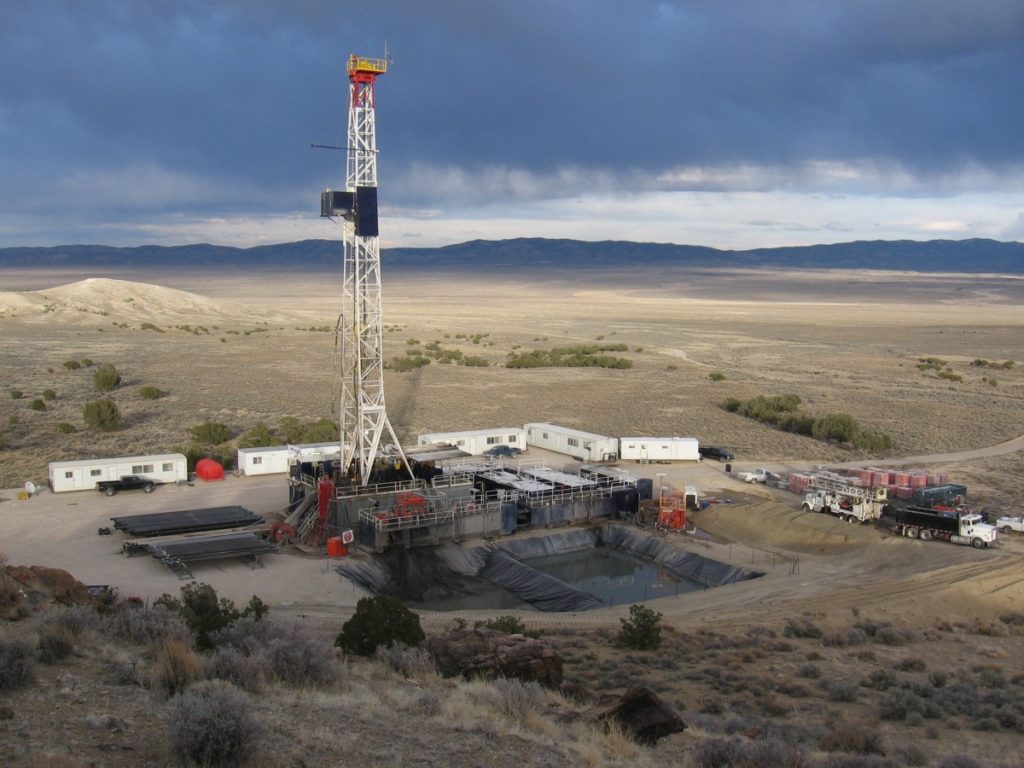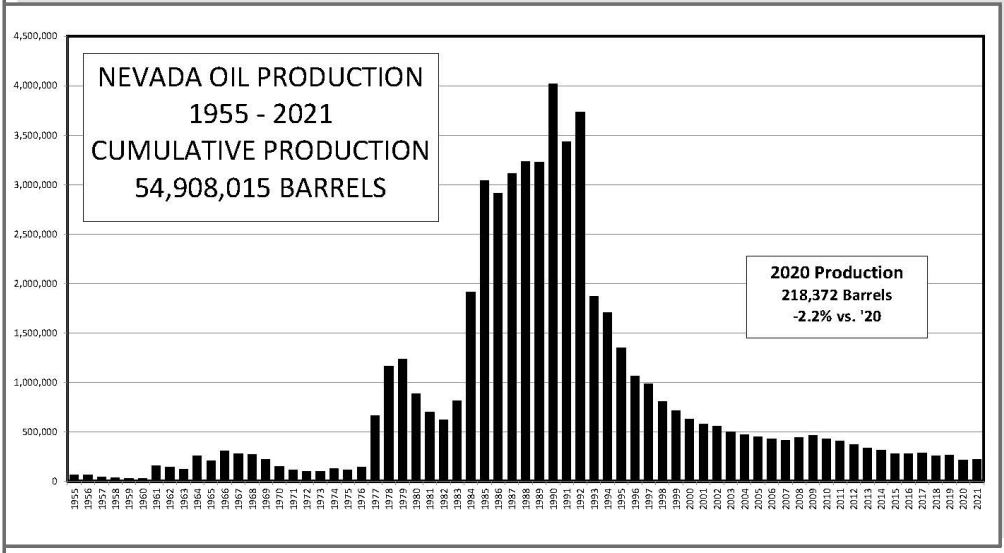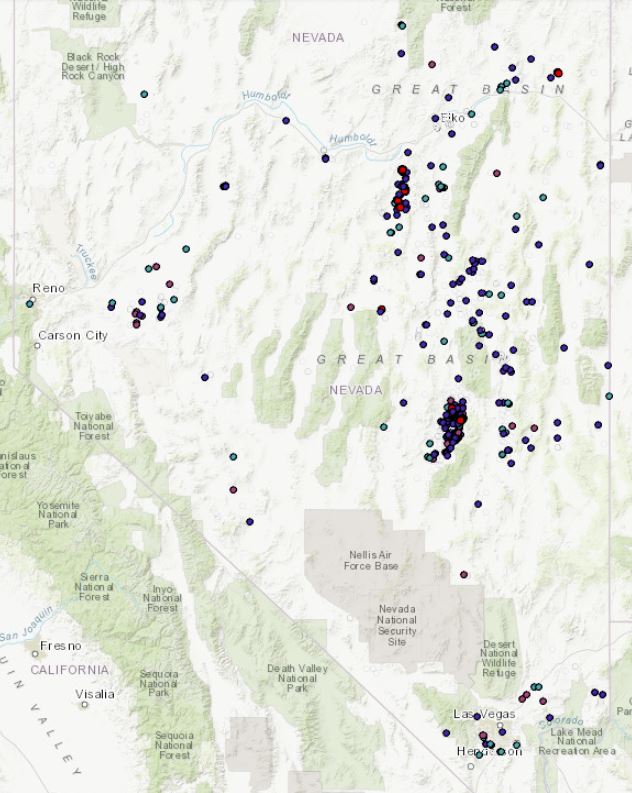Wildcat wells near Reno inspired decades of gambling.
The search for commercial amounts of petroleum in Nevada began in 1907 with a well drilled southwest of Reno. After reaching a depth of 1,890 feet, the remote wildcat in Washoe County proved unproductive — an expensive “dry hole.”
A second exploratory well was rumored to have been drilled seeking an oilfield northwest of Reno, but few details about it survived since drilling permits were not required until 1953.
Nevada’s petroleum exploration would remain on pause for decades after the attempt near Reno, according to Larry Garside, a research geologist for the Nevada Bureau of Mines and Geology.

Half of all royalties from leasing and mineral development go to the state of Nevada. Photo courtesy Nevada Bureau of Land Management.
“Rumors of oil discoveries and plans for oil development abounded in the early 1900s in Reno and several other Nevada towns,” he explained in 1988. “Newspapers commonly had articles on the purported favorability of certain regions for oil.”
The state geologist added that Nevada’s early 20th-century oil promotional activity coincided with development of the internal combustion engine and phenomenal growth in the U.S. petroleum industry to meet gasoline demand (see Cantankerous Combustion – First U.S. Auto Show).
While Texas and Oklahoma oilfields multiplied, the few exploratory wells in Nevada continued to prove fruitless. One of the unsuccessful wells was drilled in northwestern Nevada by Western Pacific Railroad Company along its tracks near the siding of Sulphur in Black Rock Desert.
Garside could find few drilling records until the 1920s, and those indicated more unsuccessful wells drilled throughout the Great Depression and World War II.

Since its first commercial well in 1954, Nevada has been considered a frontier state for small oilfields, including the historic Railroad Valley in northeastern Nye County (bottom center). Map courtesy Nevada Bureau of Mines and Geology.
First Nevada Oil Well
On February 12, 1954, Shell Oil Company finally completed the first Nevada oil well that proved commercial. “Unfortunately, it took nearly half a century and 85 dry holes before the state’s complicated geology yielded a producing oil well,” Garside noted.
Shell’s Eagle Springs No. 1 well found oil in Railroad Valley in Nye County. The discovery well reached as deep as 10,360 feet before being completed at a productive interval between 6,450 and 6,730 feet.
Despite the Eagle Springs oilfield producing 3.8 million barrels of oil by 1988, it was the state’s only oilfield for decades as more dry holes followed.
“Although this discovery encouraged drillers and speculators to drill there and elsewhere in Nevada, the next field was not found for 22 years, during which time about 100 dry holes were drilled,” Garside reported in Petroleum Exploration and Production in Nevada.
The state’s second significant oil discovery came in 1976, when Northwest Exploration Company completed the Trap Spring No. 1 well in Railroad Valley, five miles west of the Eagle Springs oilfield. The Trap Spring well produced more than seven million barrels of oil over the next two decades.

The Nevada Division of Minerals in 2022 reported the state’s annual oil production peaked in 1990 at about 4 million barrels of oil.
A third discovery came in 1978 with the Northwest Exploration’s Currant No. 1 well drilled in Railroad Valley, 6 miles north of the Eagle Springs Field. The well yielded just 646 barrels of oil, but was still producing a couple of hundred barrels of oil per year in the late 1990s.
The pace of Nevada oil discoveries accelerated considerably as exploration and drilling technologies improved. The Grant Canyon No. 3 well averaged 2,000 barrels of oil per day since production began in 1984. The well’s daily production reached as high as 4,300 barrels of oil in 1987 — the most of any onshore well in the continental United States.
According to the Nevada Bureau of Mines and Geology, the small oil wells led to more drilling and the 1983 discovery of the Grant Canyon field in Railroad Valley, which tripled Nevada’s oil production.

A 2013 map of Nevada oil and natural gas wells with red dots indicating producing wells. Map courtesy Conservation Biology Institute.
At the beginning of the 21st century, more than a dozen Nevada oilfields produced about 50 million barrels of oil, the bureau noted, adding the Grant Canyon oilfield produced more than 20.7 million barrels of oil from three wells between 1983 through 2003. “The possibility of another Grant Canyon field is what keeps oil companies interested in Nevada,” noted one bureau geologist.
Although recent drilling has focused on Nye County’s Railroad Valley, Nevada remains a frontier state with 11 small oilfields in three areas of the state, according to the Department of Energy.
“Nevada produces some oil, although total production is small relative to that of major oil states,” noted DOE’s Office of Fossil Fuels in the 2019 report “Nevada Natural Gas Flaring and Venting Regulations.”
“Most of the oil has come from the Great Basin in the eastern part of the state, primarily Railroad Valley (Nye and White Pine Counties) and Pine Valley (Elko and Eureka Counties), the report noted. The state’s peak production exceeded 4 million barrels if oil in 1990.
Annual production has declined to less than 250,000 barrels of oil since the late 2010s, and the Nevada Division of Minerals has reported a total of seven oil wells completed from 2017 to 2021 — bringing the state’s total completions to 742 wells since 1955.
“The federal government owns 81.07 percent of Nevada’s total land, 56,961,778 acres out of 70,264,320 total acres,” added Fluid Minerals Program Manager Cortney Luxford in her Summary of Oil, Geothermal, and Dissolved Minerals Activity.
_______________________
Recommended Reading: Roadside Geology of Nevada (2017). Your Amazon purchase benefits the American Oil & Gas Historical Society. As an Amazon Associate, AOGHS earns a commission from qualifying purchases.
_______________________
The American Oil & Gas Historical Society (AOGHS) preserves U.S. petroleum history. Please become an AOGHS annual supporter and help maintain this energy education website and expand historical research. For more information, contact bawells@aoghs.org. Copyright © 2025 Bruce A. Wells. All rights reserved.
Citation Information – Article Title: “First Nevada Oil Well.” Authors: B.A. Wells and K.L. Wells. Website Name: American Oil & Gas Historical Society. URL: https://aoghs.org/petroleum-pioneers/first-nevada-oil-well. Last Updated: February 7, 2025. Original Published Date: February 8, 2016.



